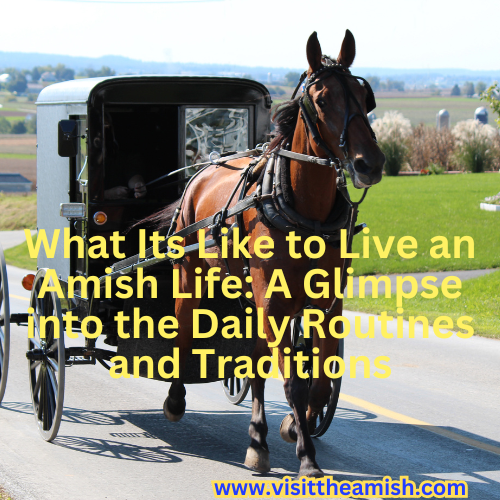Amish Daily Life: An Introduction
The Amish live a unique and distinct lifestyle rooted in simplicity, community, and strong religious values. Understanding the daily life of the Amish provides valuable insight into their culture and traditions.The Amish prioritize family, community, hard work, and adherence to traditional practices and customs.
The Amish community is known for its commitment to a simple, traditional way of life. They have intentionally chosen to live apart from the modern world and its conveniences. By adhering to their traditions and customs, the Amish seek to preserve their distinctive identity and maintain a strong sense of community.
The Amish believe that their way of life is a reflection of their deep religious convictions. They strive to live in accordance with their interpretation of biblical teachings, which emphasize humility, modesty, and separation from the secular society. The Amish lifestyle is centered around their faith, and it influences every aspect of their daily routines and interactions.
To gain a deeper understanding of the average day in the life of the Amish, it is essential to examine the roles and responsibilities of individuals within their community. By exploring the routines and traditions followed by Amish women, gaining insights from living with the Amish, and comparing their daily life to modern society, we can paint a comprehensive picture of what an average day is like for the Amish.
The Average Day of an Amish Woman
An Amish woman’s day begins with early morning prayers as a family, setting the tone for the day. She is involved in various household tasks such as cooking, laundry, cleaning, sewing, gardening, and canning. Amish women predominantly serve as stay-at-home mothers, prioritizing the care of their children and husbands. They are expected to be submissive and obedient to their husbands, with decision-making authority typically resting with the husband. Instances of abuse are limited, and divorce or separation is rare due to religious beliefs.
For example, in the morning, an Amish woman may start her day by preparing breakfast for her family. She may then proceed to do the laundry, tend to the garden, or work on other projects before preparing lunch. In the afternoon, she might engage in more yard work, canning vegetables, or help in the barn or field. Supper is prepared before milking the cows again, followed by more cleaning and folding laundry.The day ends with finishing up any remaining projects and getting everyone showered and in bed by 10:00 PM.
The daily life of an Amish woman is centered around her family and household responsibilities. Her hard work and dedication contribute to the overall functioning of the household and the well-being of her loved ones. Despite the demanding nature of her tasks, an Amish woman finds fulfillment in her role as a caregiver and provider for her family.
Amish women play a vital role in maintaining the stability and harmony of their households. They are responsible for the smooth running of the home, including cooking nutritious meals, ensuring cleanliness, and managing the family’s clothing needs. Their dedication to their duties reflects their commitment to their families and their desire to create a nurturing environment for their loved ones.
While Amish women primarily focus on their domestic responsibilities, they also hold important positions within their community. They actively participate in church activities, including volunteering for various roles during worship services and community events. Their commitment to their faith extends beyond the confines of their homes, as they contribute to the spiritual well-being of the entire Amish community.
A Day in the Life of an Amish Family
Amish families start their day early, around 4 AM, engaging in various activities. Their homes are busy and dynamic throughout the day, with strategic naps taken for rest. Each Amish family has its own specific routines, including breakfast preparation, work schedules, household tasks, and meals. Afternoon activities may involve helping neighbors or working in the fields. Evening tasks, supper, and preparations for bed conclude the day around 9:30 PM.
To illustrate, let’s consider the day in the life of a specific Amish family. Lovina’s family, for instance, begins their day by making breakfast for their son Joseph and packing his lunch. Joseph leaves for work at 4:30 AM, while Benjamin helps with construction work. Joe, who hasn’t found work yet, leaves to help at Mose and Susan’s house. The family then proceeds to do their laundry and hang the clothes up to dry. Lunch is a simple meal of meat and cheese roll-ups. Lovina and Benjamin come home in the afternoon, with Benjamin helping a neighbor. Joe picks potatoes in a field in the evening, returning home at 8 PM for supper.
The daily routines of Amish families are structured around their work, household tasks, and communal responsibilities. These routines create a sense of order and purpose in their lives, enabling them to fulfill their duties and contribute to the well-being of their families and community.
Amish families prioritize spending quality time together, engaging in activities that strengthen their bonds and create lasting memories. Family meals, shared chores, and communal gatherings foster a sense of unity and togetherness within the Amish family, reinforcing the importance of family ties in their daily lives.
Insights from Living with the Amish
Living with the Amish provides firsthand insights into their community and commitment to a simple, traditional lifestyle. Amish families tend to be large, and children actively participate in farm work and other family businesses. The Amish speak Pennsylvania Dutch, a dialect introduced by German immigrants, and learning German is mandatory for them. They primarily use horse buggies for transportation and wooden skateboards for children, and only use trains or boats for long distances. Amish houses are similar to traditional American houses but do not have lamps or light bulbs and have gas stoves with wooden ovens.
By living among the Amish, one can witness the strong sense of community that permeates every aspect of their lives. Neighbors and extended family members come together to help one another in times of need, whether it be barn raising or tending to the sick. This spirit of communal support is deeply ingrained in Amish culture and contributes to their overall well-being and resilience.
Living with the Amish also offers a glimpse into their language, transportation, and housing practices. The Amish speak Pennsylvania Dutch, a language that has its roots in German. The preservation of this language reflects their commitment to maintaining their distinct cultural identity.
In terms of transportation, the Amish rely on horse-drawn buggies and wooden skateboards for short distances. They prefer these modes of transportation as they align with their values of simplicity and stewardship of the environment. For longer distances, the Amish may opt for trains or boats.
Amish houses resemble traditional American houses in many ways, but they are distinct in their simplicity. The absence of lamps or light bulbs and the use of gas stoves with wooden ovens reflect their commitment to minimizing reliance on modern technology. These practices align with their belief in leading a simple and sustainable lifestyle.
An Ordinary Day in the Life of an Amish Woman
An ordinary day in the life of an Amish woman starts with early morning routines, including packing lunches and family members leaving for work. Throughout the day, she may receive visits from family members, complete household chores such as dishes, odds and ends jobs, and laundry. Simple meals are served at specific times, and evening activities and preparations for bed conclude the day around 9:30 PM.
For instance, let’s take a look at the daily routine of an Amish woman named Lovina. Her day begins at 3 a.m. as she packs lunches and gets ready for work. Son Benjamin leaves for his job at the RV factory at 4:30 a.m., and nephew Henry also leaves for work shortly after. Son Joseph helps nephew Noah on his construction crew. Daughter Elizabeth and Susan arrive at 8 a.m. for a visit. Breakfast is served at 9:30 a.m., followed by washing dishes and completing odds and ends jobs around the house. Lunch is served at 1 p.m., and Joe comes home from work at 1:30 p.m. The girls and their babies leave in the afternoon. Daughter Loretta leaves with her special friend to go to the hospital. Supper is served at 6:45 p.m., and Loretta returns home. Everyone gets ready for bed at 9:30 p.m..
The daily routine of an Amish woman is filled with meaningful activities that contribute to the well-being of her family and community. Her dedication to her household tasks and the care she provides to her loved ones are a testament to the importance of family and community in Amish life.
Amish women find fulfillment in their roles as wives, mothers, and caretakers of the home. Their commitment to their families extends beyond their immediate responsibilities, as they actively engage in supporting their extended families and neighbors. The bonds of kinship and community are nurtured through regular visits, shared meals, and acts of kindness.
The Importance of Family and Community in Amish Life
Family and community are of utmost importance in Amish life. The Amish emphasize strong family ties and communal living. They have a support system in place and share responsibilities among family and community members. They celebrate traditions and customs together, fostering a sense of unity and belonging.
In Amish society, the family is the cornerstone of their social structure. The Amish place great value on the sanctity of marriage and parenthood. Family ties are strengthened through regular gatherings, shared meals, and collective decision-making. The Amish recognize the importance of intergenerational relationships in passing down their values, traditions, and skills to future generations.
Community plays an equally significant role in Amish life. Amish communities are tightly knit, with members actively involved in supporting and caring for one another. Neighbors come together in times of joy and sorrow, offering help, sharing resources, and providing emotional support. The sense of belonging that comes from being part of a close-knit community contributes to the overall well-being and resilience of the Amish.
The Amish community provides a safety net for its members, ensuring that no individual is left to navigate life’s challenges alone. By prioritizing family and community, the Amish create an environment where individuals can thrive and find a sense of belonging.
Traditional Practices and Customs Followed by the Amish
The Amish follow traditional practices and customs rooted in their religious beliefs. They prioritize plain dress, simple living, and avoidance of modern technology. They rely on horse-drawn buggies and wooden skateboards for transportation, minimizing their use of cars and planes. Traditional-style houses lack lamps or light bulbs and have gas stoves with wooden ovens.
The Amish firmly believe in living a life free from the distractions and temptations of the modern world. Their commitment to plain dress and simple living is an outward expression of their faith and a way to maintain humility and modesty. By adhering to these practices, they aim to minimize pride, promote humility, and create a sense of equality among community members.
Transportation is another aspect of Amish life that reflects their commitment to simplicity and sustainability. By relying on horse-drawn buggies and bicycles or scooters, the Amish reduce their dependence on fossil fuels and minimize their impact on the environment. These traditional modes of transportation also foster a sense of connectedness with nature and promote a slower pace of life.
Amish houses are designed to be functional and practical, with minimal reliance on modern conveniences. The absence of lamps or light bulbs is a deliberate choice to limit the use of electricity and embrace natural light. The use of gas stoves with wooden ovens allows for cooking and baking without relying on electric or gas-powered appliances. These traditional practices not only reflect the Amish’s commitment to simplicity but also contribute to their self-sufficiency and resilience.
Comparison: Amish Life vs. Modern Society
Amish daily life starkly contrasts with the fast-paced, technology-dependent modern society. The Amish value simplicity, community, and adherence to religious beliefs, while modern society prioritizes convenience, individualism, and technological advancements. The impact of technology on daily routines, values, and priorities greatly differs between the two.
In modern society, technology plays a central role in daily life. From smartphones and social media to advanced medical treatments and transportation systems, technology has revolutionized the way we live, work, and communicate. The rapid pace of technological advancement has led to increased convenience and efficiency but has also brought about challenges such as information overload, social disconnection, and environmental concerns.
On the other hand, the Amish intentionally limit their use of technology to preserve their way of life and maintain a strong sense of community. They view technology as a potential threat to their values and believe that excessive reliance on it can lead to the erosion of their traditional practices and customs. By embracing a simpler way of life, the Amish seek to preserve their values, foster deep connections with nature and one another, and prioritize the well-being of their community over individualistic pursuits.
The differences between Amish life and modern society extend beyond technology. While modern society places a significant emphasis on personal achievements, career success, and material possessions, the Amish prioritize family, community, and a strong work ethic. The Amish find fulfillment in their relationships, their contributions to their community, and their commitment to a purposeful and meaningful existence.
Despite these differences, there are also areas where Amish life and modern society intersect. Both value the well-being of individuals and seek to create a sense of purpose and belonging. Furthermore, the Amish and modern society share a desire for happiness and fulfillment, albeit through different means.
The Role of Religion in Shaping Amish Daily Life
Religion plays a significant role in shaping Amish daily routines and practices. The Amish have a strong religious foundation, with prayer and worship guiding their actions and decisions. They observe religious holidays and traditions, which shape the rhythm of their daily lives.
The Amish’s religious beliefs provide a moral compass and a sense of purpose in their daily lives. Their faith influences their interactions with others, their approach to work, and their overall outlook on life. The Amish prioritize religious practices such as daily prayers, regular church attendance, and participation in community events.
The observance of religious holidays and traditions is a central part of Amish life. These occasions bring the community together, strengthen social bonds, and provide opportunities for spiritual reflection and renewal. Whether it is Easter, Christmas, or other significant religious events, the Amish celebrate these occasions with reverence and joy.
Religion also shapes the ethical framework within which the Amish live their lives. Their religious beliefs guide their decision-making processes, encouraging behaviors that align with their values of humility, simplicity, and community. By adhering to their religious principles, the Amish strive to lead a righteous and meaningful existence.
The Importance of Work in Amish Life
Work is highly valued within the Amish community. The Amish have a strong work ethic and engage in various types of work such as farming, construction, and other trades. Their work contributes to the local economy and promotes self-sustainability within their community.
The Amish view work as a means of providing for their families and contributing to the well-being of their community. They embrace a holistic approach to work, recognizing its spiritual and practical dimensions. Work is seen as a form of worship, and the Amish take pride in the craftsmanship and dedication they bring to their chosen occupations.
The agricultural sector plays a crucial role in the Amish economy. Many Amish families engage in farming, cultivating crops, and raising livestock. Farming is not merely a means of sustenance but also a way of life for the Amish. It allows them to connect with nature, provides food for their families, and enables them to contribute to the local food system.
In addition to farming, the Amish are skilled in various trades such as woodworking, construction, and craftsmanship. These skills are passed down through generations, ensuring the preservation of traditional practices and fostering a sense of pride in their work. The Amish’s commitment to quality and attention to detail is evident in their handcrafted furniture, quilts, and other products.
Through their work, the Amish contribute to the economic well-being of their community. They prioritize self-sufficiency and strive to minimize their reliance on external resources. By engaging in productive and meaningful work, the Amish create a sense of fulfillment and purpose in their lives.
Conclusion
In conclusion, the daily life of the Amish is characterized by simplicity, hard work, strong family ties, and adherence to traditional practices and customs. Understanding their unique way of life provides valuable insights into their culture and traditions. The Amish prioritize family, community, and religious beliefs, which shape their daily routines and guide their actions.
The average day for an Amish woman is centered around her family and household responsibilities. From early morning prayers to engaging in various household tasks, she plays a vital role in maintaining the well-being of her loved ones and contributing to the overall functioning of her community. The Amish place a strong emphasis on family and community, recognizing their importance in creating a sense of unity and belonging.
Living with the Amish offers a firsthand experience of their community and commitment to a simple, traditional lifestyle. By observing their language, transportation practices, and housing arrangements, one can gain a deeper appreciation for the values and choices that shape their daily lives. The Amish’s deliberate limitations on technology and their strong work ethic set them apart from modern society, highlighting the contrasting priorities and values of the two.
Religion plays a central role in shaping Amish daily life. The Amish’s religious beliefs provide a moral compass and influence their decision-making processes. Their commitment to religious practices and observance of religious holidays foster a sense of spirituality and community within their daily routines.
Work is highly valued within the Amish community. The Amish engage in various types of work, contributing to the local economy and promoting self-sustainability. Their strong work ethic, coupled with their commitment to quality and craftsmanship, reflects their dedication to living a purposeful and meaningful life.
In essence, the average day for the Amish is a testament to their commitment to simplicity, community, and religious values. Their way of life offers an alternative perspective on what it means to lead a fulfilling and meaningful existence. By appreciating the unique aspects of Amish daily life, we can gain insights into the importance of family, community, and adherence to traditional practices in fostering a sense of belonging and purpose.
Like this:
Like Loading...












